Pushing composed images to AWS
Weldr aka. Composer can generate images suitable for uploading to Amazon Web Services, and starting an EC2 instance. The images have the right partition layout, and include cloud-init.
Prerequisites
We’ll use Fedora 29 as our OS of choice for running this. Run this in its own VM with at least 8 gigabytes of memory and 40 gigabytes of disk space. Lorax makes some changes to the operating system its running on.
First install Composer:
$ sudo yum install lorax-composer cockpit-composer cockpit composer-cli
Next make sure to turn off SELinux on the system. Lorax doesn’t yet work properly with SELinux running, as it installs an entire OS image in an alternate directory:
$ sudo setenforce 0
$ sudo sed -i 's/^SELINUX=.*/SELINUX=permissive/' /etc/selinux/config
Now enable and start lorax-composer system service:
$ sudo systemctl enable --now lorax-composer.socket
If you’re going to use Cockpit UI to drive Composer (see below), you can also enable it like this:
$ sudo systemctl enable --now cockpit.socket
$ sudo firewall-cmd --add-service=cockpit && firewall-cmd --add-service=cockpit --permanent
Install the AWS client tooling:
$ sudo yum install python3-pip
$ sudo pip3 install awscli
Make sure you have an Access Key ID configured in AWS IAM account manager and use that info to configure the AWS command line client:
$ aws configure
AWS Access Key ID [None]: ............
AWS Secret Access Key [None]: .............
Default region name [None]: us-east-1
Default output format [None]:
Make sure you have an appropriate S3 bucket. We’ve called
ours examplecomposer but yours must be globally unique, so you can’t choose
the same name:
$ BUCKET=composerredhat
$ aws s3 mb s3://$BUCKET
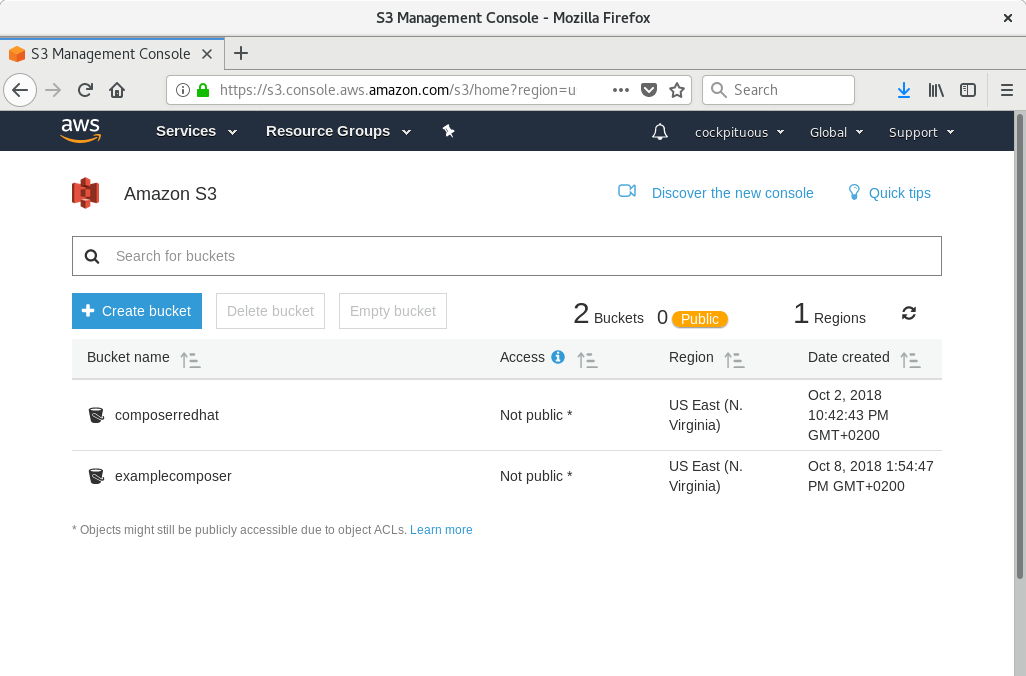
If you haven’t already, create a vmimport S3 Role in IAM and grant it
permissions to access S3. This is how you do it from the command line:
$ printf '{ "Version": "2012-10-17", "Statement": [ { "Effect": "Allow", "Principal": { "Service": "vmie.amazonaws.com" }, "Action": "sts:AssumeRole", "Condition": { "StringEquals":{ "sts:Externalid": "vmimport" } } } ] }' > trust-policy.json
$ printf '{ "Version":"2012-10-17", "Statement":[ { "Effect":"Allow", "Action":[ "s3:GetBucketLocation", "s3:GetObject", "s3:ListBucket" ], "Resource":[ "arn:aws:s3:::%s", "arn:aws:s3:::%s/*" ] }, { "Effect":"Allow", "Action":[ "ec2:ModifySnapshotAttribute", "ec2:CopySnapshot", "ec2:RegisterImage", "ec2:Describe*" ], "Resource":"*" } ] }' $BUCKET $BUCKET > role-policy.json
$ aws iam create-role --role-name vmimport --assume-role-policy-document file://trust-policy.json
$ aws iam put-role-policy --role-name vmimport --policy-name vmimport --policy-document file://role-policy.json
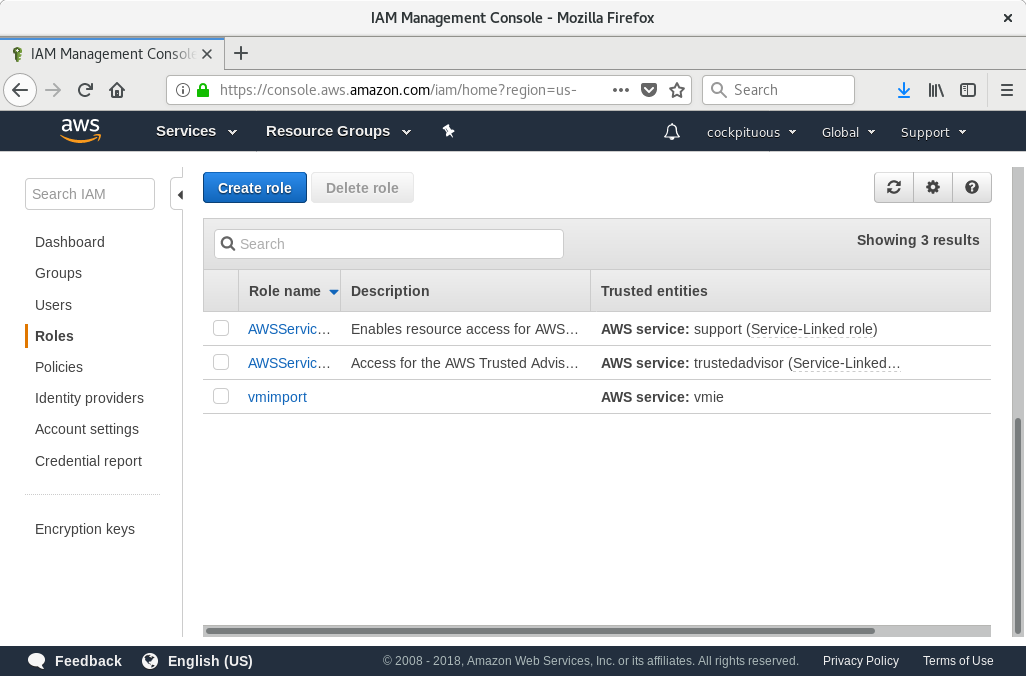
Compose an image from the UI
To compose an image in Composer, log into the Cockpit Web Console with your web browser.
It’s running on port 9090 on the VM that you’re running Composer in. Use any admin
or root Linux system credentials to log in. Select the Image Builder tab.
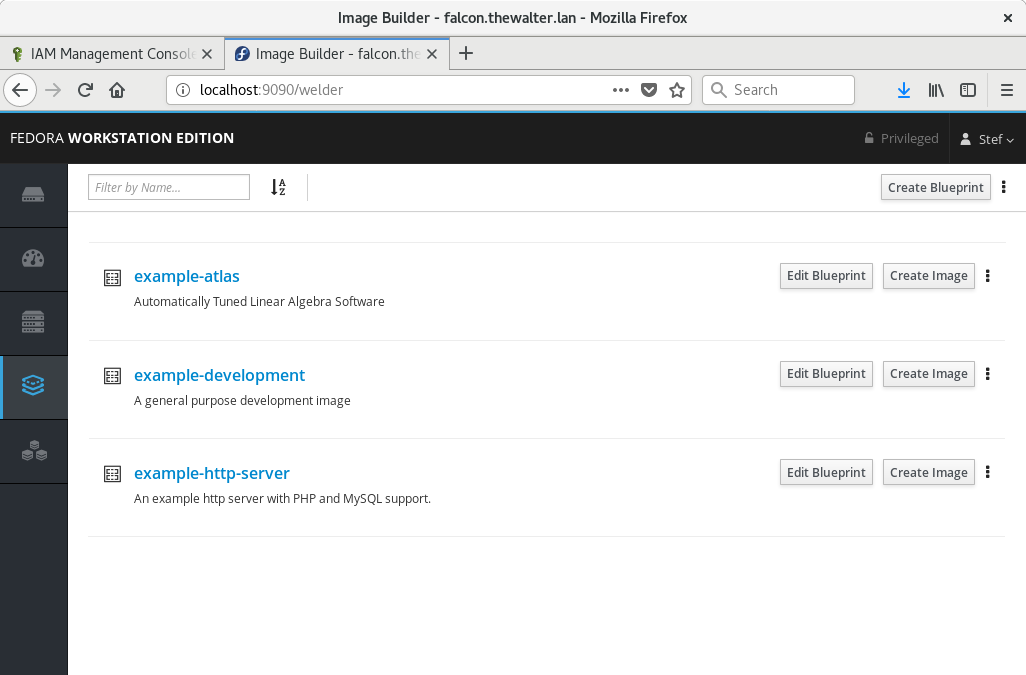
We first have to have a blueprint defined. This blueprint describes what goes into the image.
For the purposes of this example we’ll use the example-http-server blueprint, which
builds an image that contains a basic HTTP server.
Click on the Create Image button and choose Amazon Machine Image from the dropdown to choose the Image Type:
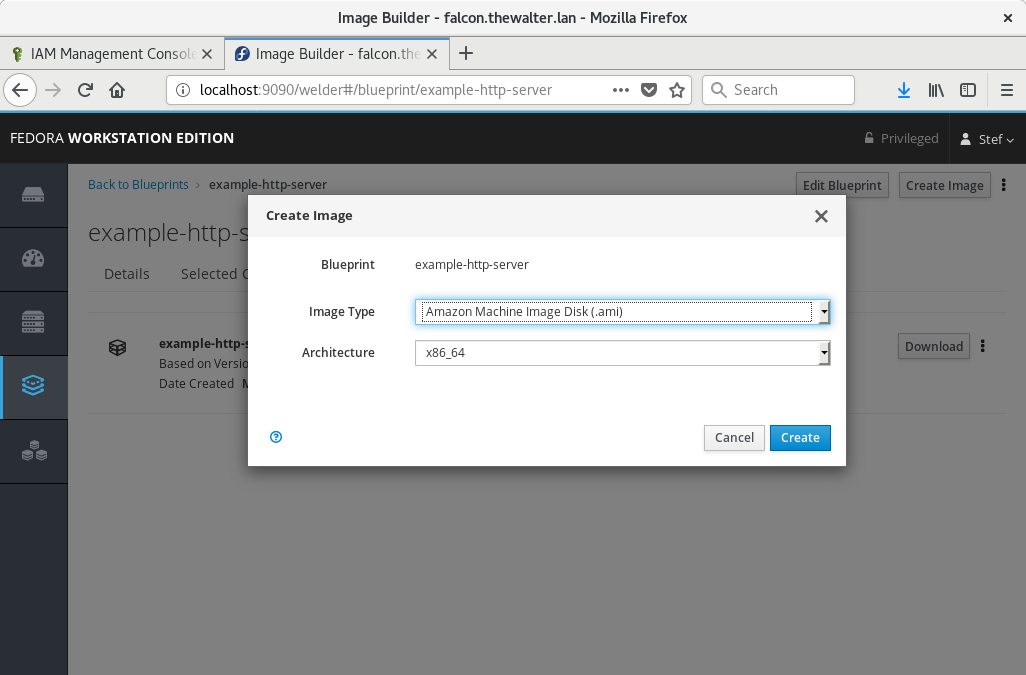
If you click on the blueprint, you should see progress described on the Images tab:
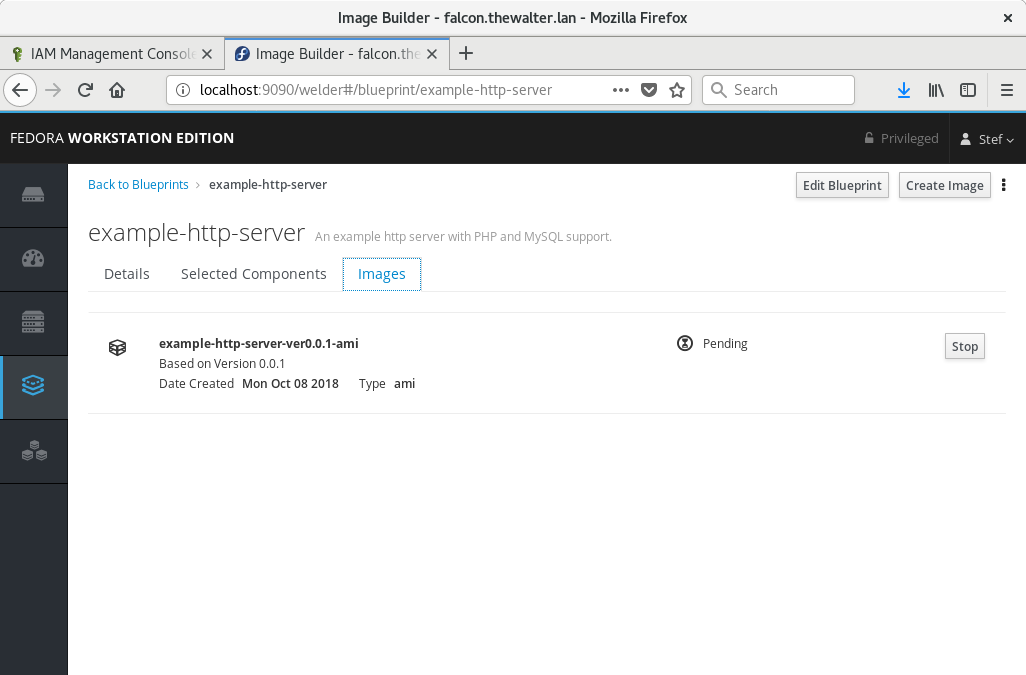
Once it’s done, download the image:
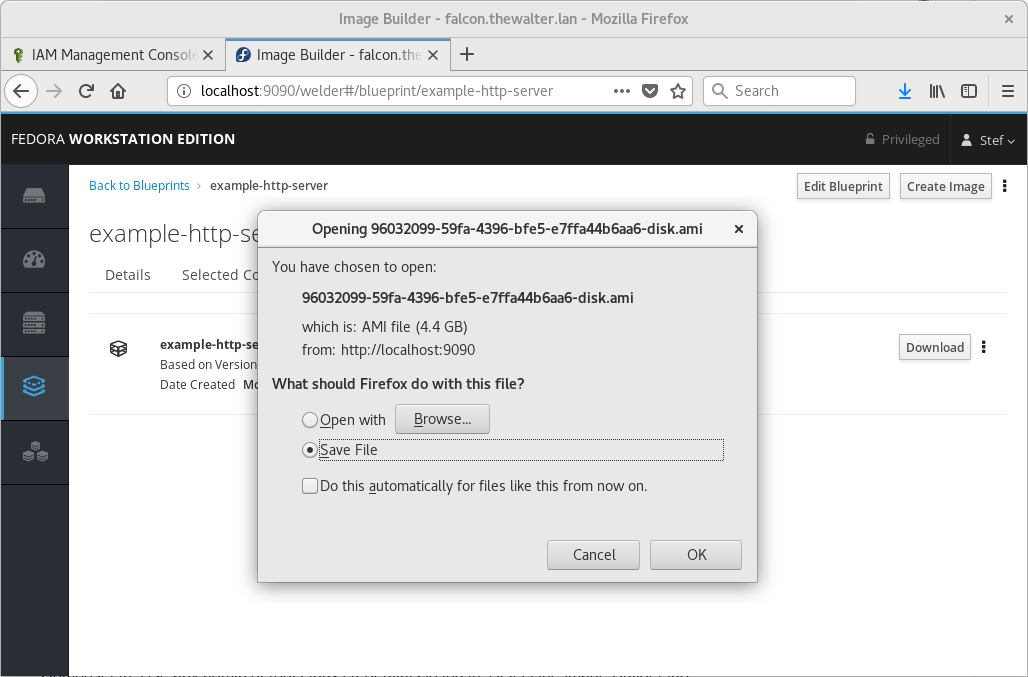
Compose an image from the CLI
To compose an image in Composer from the command line, we first have to have a blueprint
defined. This blueprint describes what goes into the image. For the purposes of this
example we’ll use the example-http-server blueprint, which builds an image that
contains a basic HTTP server.
We run the following command to start a compose. Notice that we pass the image type
of ami which indicates we want an image appropriate for pushing to
Amazon Web Services.
$ sudo composer-cli compose start example-http-server ami
Compose 8db1b463-91ee-4fd9-8065-938924398428 added to the queue
Now check the status of the compose like this:
$ sudo composer-cli compose status
8db1b463-91ee-4fd9-8065-938924398428 RUNNING Mon Oct 8 08:11:33 2018 example-http-server 0.0.1 ami
In order to diagnose a failure or look for more detailed progress, see:
$ sudo journalctl -fu lorax-composer
...
When it’s done you can download the resulting image into the current directory:
$ sudo composer-cli compose image 8db1b463-91ee-4fd9-8065-938924398428
8db1b463-91ee-4fd9-8065-938924398428-disk.ami: 4460.00 MB
Pushing and using the image
So now you have an image created by composer, and sitting in the current working directory. Here’s how you push it to S3 and start an EC2 instance:
$ AMI=8db1b463-91ee-4fd9-8065-938924398428-disk.ami
$ aws s3 cp $AMI s3://$BUCKET
Completed 24.2 MiB/4.4 GiB (2.5 MiB/s) with 1 file(s) remaining
...
Once the upload to S3 completes, we import it as a snapshot into EC2:
$ printf '{ "Description": "CentOS image", "Format": "raw", "UserBucket": { "S3Bucket": "%s", "S3Key": "%s" } }' $BUCKET $AMI > containers.json
$ aws ec2 import-snapshot --disk-container file://containers.json
You can track the status of the import using the following command:
$ aws ec2 describe-import-snapshot-tasks --filters Name=task-state,Values=active
Next create an image from the uploaded snapshot, by selecting the snapshot in the EC2 console, right clicking on it and selecting Create Image:
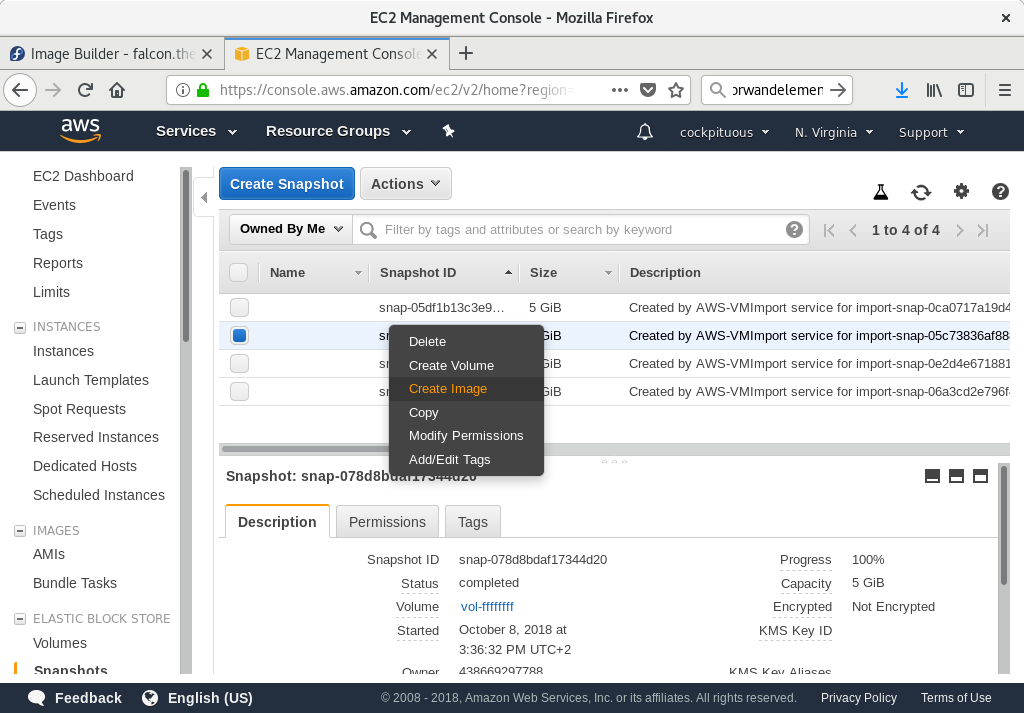
Make sure to select the Virtualization type of Hardware-assisted virtualization in the image you create:
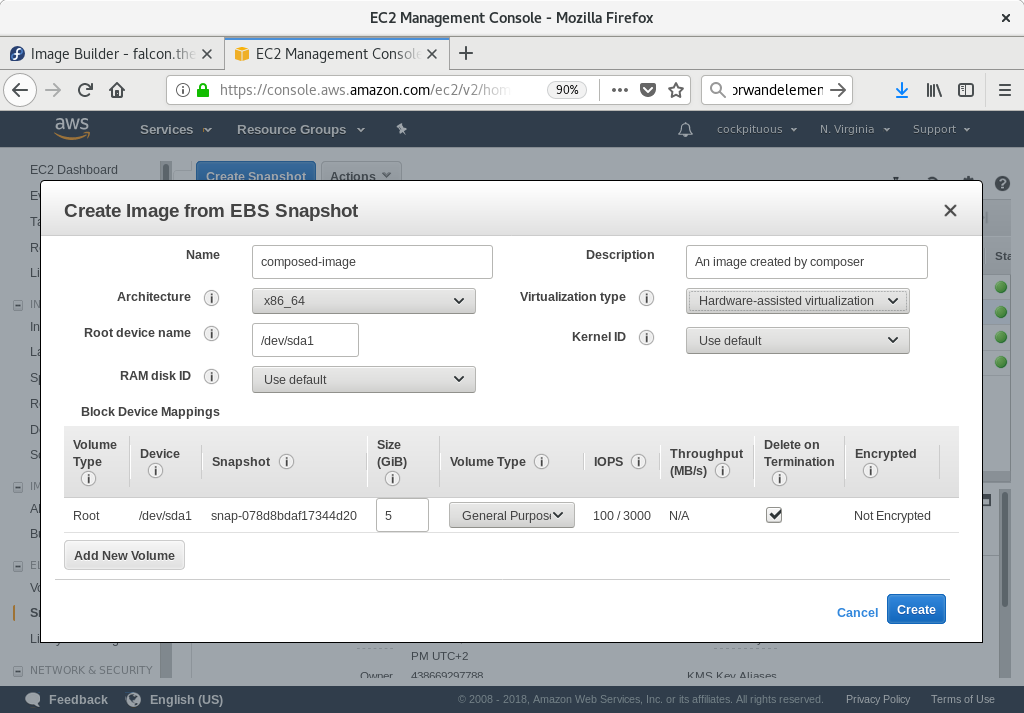
Now you can run an instance using whatever mechanism you like (CLI or AWS Console)
from the snapshot. Use your private key via SSH to access the resulting EC2
instance as usual. The user to log in as is ec2-user